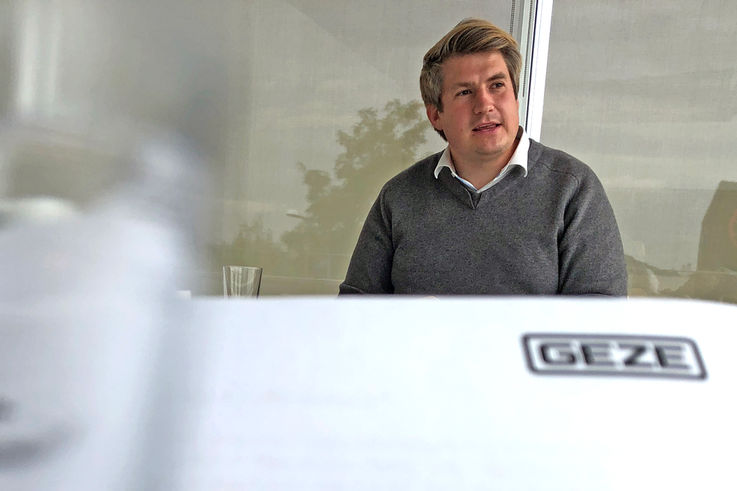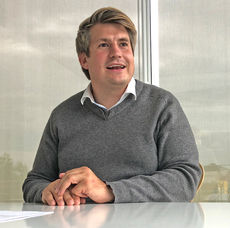Trends and challenges in healthcare – GEZE in conversation with Magnus Nickl
GEZE solutions have been setting standards in healthcare for years. One reason for this is that we network closely with many stakeholders. This is the only way we understand the needs and wishes of our customers and partners and improve our products and solutions. When we talk about healthcare and hospital buildings, the subject of “healing architecture”" is unavoidable. And then the name “Nickl & Partner Architects” soon gets mentioned. We met Magnus Nickl, board member of the international architect's practice, at the headquarters in Munich to discuss the latest trends and challenges in healthcare with him.
GEZE: There are many different demands on door and window products in healthcare – some key words here are accessibility, hygiene, indoor climate and emergency exit protection. One feature of this industry is the influence of architecture on the health and well-being of patients – known as healing architecture. What was your motivation for tackling this subject and how did the concept and the term “healing architecture” arise?
Magnus Nickl: That goes a long way back. Healing architecture dates back more than 40 years now, to my father Professor Hans Nickl. After studying architecture, he asked himself: “What really interests me? What might be a niche where I as an architect can make a real social contribution?” Of course he has built the obligatory church and experienced all the highs and lows that come with construction. Building housing never interested him much. And office buildings were ultimately too simple for him. So immediately after leaving university he joined an office that at the time was building hospitals. But that was in the 60s and 70s, when they were traditional utility buildings. They mainly looked at grid system. What is the ideal grid? How can we get all the functions in? So, I.e. how can be make the hospital attractive, economical and practical, sort of “square, practical, good"? This is where the early idea arose of creating a different type of hospital architecture, a different philosophy, which focused primarily on the patient and their recovery. These were the fundamentals of “healing architecture”, which constantly developed with numerous projects, publications and with my mother's professorship.

For large construction projects, Magnus Nickl recommends close and early cooperation between industry and the architect. © GEZE GmbH
GEZE: What are the basic principles of the concept of “healing architecture”?
M.N.: The basic principles originate from the beginning of our architect's practice. And of course light is critical here. It was always important for us that every patient's room had a reference to the outside. Our corridors are not dark tubes, but instead provide clear orientation. We value different courtyards, which can be arranged in different way. The view through the window to the outside is important. Overall, our room designs are fluid and you move like a symphony, like a piece of music, through the building. Through the foyer, the public areas, into a type of semi-private area. These are the examination and treatment rooms, which are already a bit more secluded. Into the private sphere, so the patient rooms, which actually become a temporary home where the patient feels safe and secure.
We want the spatial elements to be fluid and for people to move as though in a symphony, as a kind of melody through the building. The challenge is then to create spaces that offer security and safety but which are still very open.
Magnus Nickl, architect and member of the management board of Nickl & Partner ArchitectsGEZE: Safety and security are the right key words when it comes to avoiding the risks of infection, for example. Here, we provide solutions for low-contact door and window technology. What are the specific needs, in your opinion?
M.N.: I am very much in favour of the general use of automatic sliding doors or doors that can be operated with the elbow, to minimise hand contact. And not just doors and windows, but wash basins with infra-red too, for example. Ultimately, the aim is to prevent possible sources of infection by using automation solutions in the operating theatres in particular. For this is a hotly disputed subject in hospitals – and a huge problem! If I had my way, automatic sliding doors would not be restricted to the operating theatres alone. Apart from the hygiene aspect, interesting architectural solutions can also be found on the wards. I recently saw a great project in the Netherlands: The rooms on the wards had large sliding doors. In Germany, the cost means this is rather unlikely, but as a result these patient rooms were of a very high quality because there were very wide corridors where different functions took place, such as open tea kitchens, lunch, and so on. But at the same time, patients were able to close the sliding doors to ensure their private space. And again, this creates a very fluid spatial concept that to me is very exciting. And this is where you as a manufacture have lots to contribute going forward.

Magnus Nickl - architect and member of the management board of Nickl & Partner Architects
Magnus Nickl completed his architecture studies in 2014 at the ETH University of Applied Sciences in Zurich. Following a three-year research spell in Singapore and a PhD, he opened a new office in Zurich. From here, he coordinates many international hospital and research construction projects.
GEZE products are used in several Nickl & Partner Architects construction projects, for example the Parent-Child Centre at Bonn University Hospital that was completed in 2020.
GEZE: Talking of the future, one more question about digitalisation and BIM. We support our customers at a very early phase of the project in the planning of buildings. What are your experiences with BIM?
M.N.: In international terms, the subject of BIM has to be considered differently. Here in the German-speaking world – Austria, Germany and Switzerland – it is still in its infancy. The USA and some Asian countries are much further ahead. But of course, such digitalisation is an enormous challenge for industry and also for us as architects. We often have the problem in tenders that all this know-how simply isn't available. Just try calling various companies and asking for a Revit file for a specific door drive! Too many of them cannot do it. At the same time, we unfortunately often have to remain neutral because 80 per cent of our construction projects are in the public sector. We are constantly faced with the question as to what extent want and are able to use templates from individual providers – fully aware that we will possibly have to change them again after winning the contract and recalculate everything.
GEZE: It sounds as though building planning is still a challenge – and by the way: you can download the Revit file from us… But BIM also has the advantage that a holistic building life cycle can be considered. How do you see this, and what demands do operators make on you here?
M.N: The entire life cycle consideration is becoming increasingly important – and the advantages of BIM are obvious here. It means you can easily say of the attributes: this or that door drive has a moving part or a belt with a life cycle of three years. And then the facility manager can automatically order the part via the maintenance system and proactively replace it. As a result, I can achieve the ultimate goal of every operator: zero downtime. Imagine that an important treatment room, which is needed especially in times of Covid, can no longer be used. And then you call the facility manager and they have to phone round to find a V-belt and then order it. This is exactly what shouldn't happen, because it takes too long. This is the great challenge for the future, that all these models can prevent precisely that. With BIM and the consistent digitalisation, we have the opportunity to reduce downtime immensely and to act proactive and entirely in the interests of the operator – and ultimately also of the patients.
GEZE: Mr Nickl, many thanks for the interesting chat!
GEZE – partner to architects and planners
You can download our BIM door objects free of charge at bim.geze.com and integrate them into your CAD system. We can help you create BIM processing plans and help with the demands necessary for door objects to ensure proper and integrated door planning.
Because we think in terms of solutions that combine products, software and services, we get involved right from the start of your project. We can relieve you of the work of dealing with door and element lists, for instance, so you can concentrate on what is most important.


